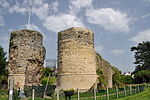Bungay railway station
BungayDisused railway stations in SuffolkFormer Great Eastern Railway stationsPages with no open date in Infobox stationRailway stations in Great Britain closed in 1953 ... and 2 more
Railway stations in Great Britain opened in 1860Use British English from January 2017

Bungay railway station was located on the now disused Waveney Valley Line which ran between Tivetshall and Beccles. The station was closed in 1953 and the buildings eventually demolished to make way for the A143 road. It was one of two stations in Suffolk on the line, which curved across the county boundary then back into Norfolk.
Excerpt from the Wikipedia article Bungay railway station (License: CC BY-SA 3.0, Authors, Images).Bungay railway station
Old Railway Road, East Suffolk
Geographical coordinates (GPS) Address Nearby Places Show on map
Geographical coordinates (GPS)
| Latitude | Longitude |
|---|---|
| N 52.4576 ° | E 1.4289 ° |
Address
Old Railway Road
NR35 1HG East Suffolk
England, United Kingdom
Open on Google Maps









